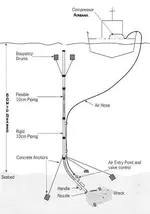divingdave
Tenderfoot
- Joined
- Oct 4, 2014
- Messages
- 3
- Reaction score
- 0
- Golden Thread
- 0
- Primary Interest:
- All Treasure Hunting
- #1
Thread Owner
I have searched high low for information on using airlifts at 60 msw but have not found anything. Anybody here have experience using an Airlift at this depth. I need to find out what size compressor I would need for this depth? I have a fairly large diving compressor onboard and wonder if this would cut it. The wooden wreck and cargo is buried under sand and silt. Diving on CCR so can do 30-60 minute bottom times at 60m and wondering if this would be an effective method for removing sediment.
I can put the boat on a four point anchor and hold over the site and have bought a couple of hundred metres of LP hosing to supply the Airlift from the compressor but not tried it at this depth. Can anyone point me in the direction of airlift tables, comparing depth, supply gas pressures and hose diameters?
Any help would be greatly appreciated.
I can put the boat on a four point anchor and hold over the site and have bought a couple of hundred metres of LP hosing to supply the Airlift from the compressor but not tried it at this depth. Can anyone point me in the direction of airlift tables, comparing depth, supply gas pressures and hose diameters?
Any help would be greatly appreciated.




